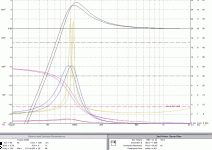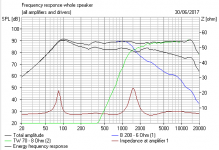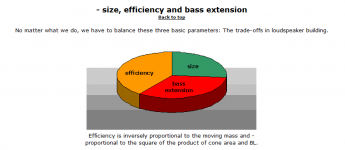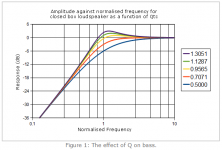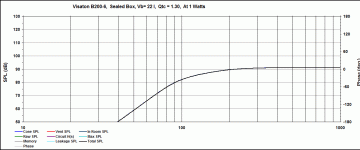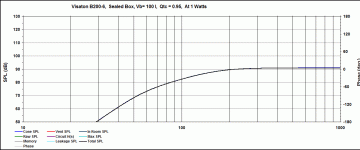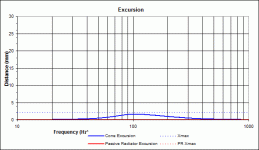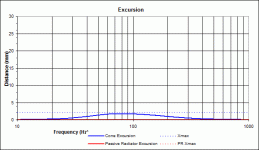Hi And thanks for reading this post.
I purchased a couple of visaton b200 8-inch drive units for use in a 5.1 audio set up. I have an active sub set at 120hz crossover frequency, the visatons are being used as satellite speakers handling everything over 120hz.
It appears the visatons like to be loaded into large sealed boxes. Unfortunatly i only have small bookshelf type boxes to put the visatons into, with a volume of just 0.75 cubic feet.
How will the small boxes affect the sound quality of the visatons, will i get colouration, inaccurate reproduction?
What is the effect of loading drive units intended for large enclosures, into small enclosures, if it is just detrimental to the bass then this is okay.
Many Thanks. John.
I purchased a couple of visaton b200 8-inch drive units for use in a 5.1 audio set up. I have an active sub set at 120hz crossover frequency, the visatons are being used as satellite speakers handling everything over 120hz.
It appears the visatons like to be loaded into large sealed boxes. Unfortunatly i only have small bookshelf type boxes to put the visatons into, with a volume of just 0.75 cubic feet.
How will the small boxes affect the sound quality of the visatons, will i get colouration, inaccurate reproduction?
What is the effect of loading drive units intended for large enclosures, into small enclosures, if it is just detrimental to the bass then this is okay.
Many Thanks. John.
It appears the visatons like to be loaded into large sealed boxes. Unfortunatly i only have small bookshelf type boxes to put the visatons into, with a volume of just 0.75 cubic feet.
The Qts of the driver is pretty high at 0.75 to allow the driver to work on an open baffle. The smaller the cabinet that you put it in the higher it will rolloff in the low frequencies. But you will get a bump before the rolloff from the high Q. If you stuff the cabinet quite densely that will increase the apparent volume inside the box and lower the rolloff point somewhat. Polyfill works for the increase in volume but it is nowhere near as effective as fibreglass or wool at damping cabinet resonances or absorbing the rear wave from the driver.
Hard to say as it depends on the box construction but if you stuff it well you will significantly reduce the contribution from the box. The higher rolloff is what you will notice from putting it in a smaller box. If you want to know the predicted rolloff point then you will need to simulate it. The program I use doesn't have that driver in the database so it would take me a little bit of time to manually enter the details and simulate it for you.How will the small boxes affect the sound quality of the visatons, will i get colouration, inaccurate reproduction?
What is the effect of loading drive units intended for large enclosures, into small enclosures, if it is just detrimental to the bass then this is okay.
If you don't have measurement capability and are just going to set a 120Hz crossover in a HT Receiver then I wouldn't worry about it, it will work OK. The frequency response will be a bit lumpy anyway from a full range in a box with no baffle step compensation or other EQ.
Last edited:
The Visaton is of a Q such that it wants either an OB or a really big box. If you can’t do a box this big (a situation i am in with my B200 project) the next best option is an aperiodic enclosure. This can be a heavily stuffed TL or with your small enclosure a heavly damped vent (like the Dyna A25) — as far from the driver as possible. Heavily stuffing the box makes it appear to be bigger than it is physically.
Here is a sim of the B200 in a 21.2 litre (0.75 ft^3) undamped box (upper curve). Adding damping and aperiodic vent will reduce the magnitude of the peak. The 2nd curve is the effect of just damping the box (assume a 20% increase in apparent volume).
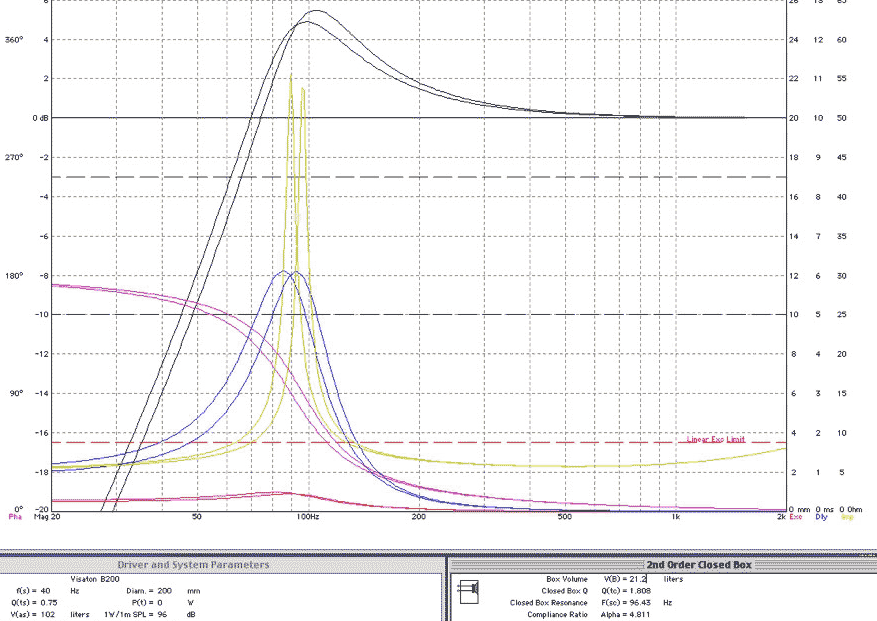
Do note that the efficiency spec is very optimistic. I have measured ~90 dB for mine.
dave
Here is a sim of the B200 in a 21.2 litre (0.75 ft^3) undamped box (upper curve). Adding damping and aperiodic vent will reduce the magnitude of the peak. The 2nd curve is the effect of just damping the box (assume a 20% increase in apparent volume).
Do note that the efficiency spec is very optimistic. I have measured ~90 dB for mine.
dave
Attachments
Adding damping and aperiodic vent will reduce the magnitude of the peak.
Either that or remove the back of the enclosure if possible.
With Qts at 0.75, an open baffle would be a great candidate.
B 200 - 6 Ohm
How bad is it? Do you think the visatons are totally unsuitable for such small enclosure, and i should try different drivers.
I have tried the visatons by removing the back of the 0.75 ft3 box and the sound was thin, compared to placing them in a sealed box. The problem is i don't have the space in my living room to place the visatons 3 feet away from walls, as a few posts have indicated.
I have also tried some decent quality 5-inch audax drivers, and again the visatons in an open back box sounded thin. Is this a trade of for gaining the advantage of open baffle, at the expense of thinness.
I have tried the visatons by removing the back of the 0.75 ft3 box and the sound was thin, compared to placing them in a sealed box. The problem is i don't have the space in my living room to place the visatons 3 feet away from walls, as a few posts have indicated.
I have also tried some decent quality 5-inch audax drivers, and again the visatons in an open back box sounded thin. Is this a trade of for gaining the advantage of open baffle, at the expense of thinness.
Last edited:
The open baffle will suffer dipole rolloff generally 6dB/oct depending on the size and shape of the baffle.
The "thinness" is the fact there is now less low frequency output due to the front to back cancellation.
To get the open baffle to resemble the closed box in frequency response you need to use EQ to offset the dipole rolloff.
Here is a good place to start reading if you want to understand the mechanism and how to can correct it
Electro-acoustic models
The "thinness" is the fact there is now less low frequency output due to the front to back cancellation.
To get the open baffle to resemble the closed box in frequency response you need to use EQ to offset the dipole rolloff.
Here is a good place to start reading if you want to understand the mechanism and how to can correct it
Electro-acoustic models
Hello John, it seems that you could use a high pass filter of some sort for the B200's, a passive should be carefully designed not to lower the impedance too much. Visaton Boxsim would probably be the easiest way to check if that would work. Is there an electronic high pass function that you could turn on?
B 200 - 6 Ohm
Yup, it doesn't look good in 22L. I get the same result as planet10.
I just ran it past Visaton Boxsim.
Needs big 70-100L box or flat baffle as the visaton driver data says. And even then, high efficiency goes with limited bass extension. Laws of physics.
Yup, it doesn't look good in 22L. I get the same result as planet10.
I just ran it past Visaton Boxsim.
Needs big 70-100L box or flat baffle as the visaton driver data says. And even then, high efficiency goes with limited bass extension. Laws of physics.
Attachments
Last edited:
While the forum was down for awhile the question from OP disappeared too, so my answer is that high pass filter is a solution to the issue caused by housing B200 in a too small of an enclosure. If you strive for perfection, then acoustical summing between woofer and B200 should be managed in a smooth way, meaning no bump appearing. One should model it carefully.
Hi. Thanks for the replies.
I can eq and smooth out the frequency response of the visaton, which according to other forum posts is a good way and takes all the experimentation out.
What i am trying to find out is will this be enough to get good sound, or is it a bad idea to use drivers intended for large enclosures in a small enclosure, i thought as they are just for midrange reproduction a small box might be okay
Many thanks
I can eq and smooth out the frequency response of the visaton, which according to other forum posts is a good way and takes all the experimentation out.
What i am trying to find out is will this be enough to get good sound, or is it a bad idea to use drivers intended for large enclosures in a small enclosure, i thought as they are just for midrange reproduction a small box might be okay
Many thanks
Thanks for the replies.
What makes you say that it can work very well? What do you base this on?
Can you expand on that in any way. If a manufacturer states a driver works well in a large enclosure, what are the deleterious effects of moving the driver into a small enclosure.
Thank you.
What makes you say that it can work very well? What do you base this on?
Can you expand on that in any way. If a manufacturer states a driver works well in a large enclosure, what are the deleterious effects of moving the driver into a small enclosure.
Thank you.
what are the deleterious effects of moving the driver into a small enclosure.
A big bump at the bottom just before it rolls off. Minimize it with dampng and an aperiodic box and then if necessary use the hi-pass filter or EQ to tame the rest.
dave
To make this B200 unit work good in a 22 lit sealed cabinet, no aperiodic damping needed, calls for a LR high pass circuit with a XO frequency at about 190 Hz to arrive acoustically at 120 Hz ( -6dB) to meet the subwoofer low passed curve, as desired by OP. The simulated curves of excursion show that a smaller enclosure benefits the driver not to receive unnecessary motion at lower frequencies. Power input for those is 50W.
Leakage losses were set at 30( very small leaks), and absorbtion losses at 10 ( stuffed box). Qtc values are calculated on enclosure volume and other Q values, but once you introduce a high pass filter, mean nothing.
Leakage losses were set at 30( very small leaks), and absorbtion losses at 10 ( stuffed box). Qtc values are calculated on enclosure volume and other Q values, but once you introduce a high pass filter, mean nothing.
Attachments
Last edited:
- Status
- This old topic is closed. If you want to reopen this topic, contact a moderator using the "Report Post" button.
- Home
- Loudspeakers
- Multi-Way
- enclosure volume advice needed
